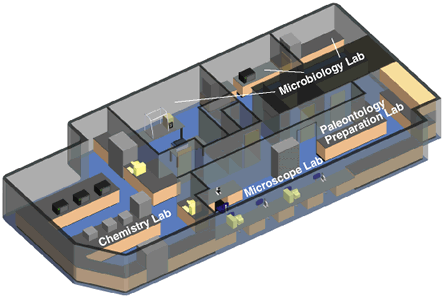JOIDES Resolution Tour 1985–2005
JOIDES Resolution: Fo'c'sle Deck/Level 5
Lab layout of the JOIDES Resolution
The XRD/XRF lab provides diffraction and fluorescence data. An Applied Research Laboratory 8400 duel spectrometer XRF provides whole-rock analysis of major and trace elements. A Philips ADP 3520 XRD and associated software allows for powder diffraction analysis of minerals and rock powders.
The Thin Section lab provides thin sections of lithified and non-lithified materials. Technicians can provide single or multiple sections.

The Chemistry lab is capable of providing both organic and inorganic geochemical analyses. The primary responsibility of shipboard organic geochemists is to provide data on petroleum hydrocarbons for safety and environmental concerns. In addition, instrumentation is available for determining (1) the source, amount, and maturity of organic matter, carbonate content, total carbon, nitrogen, and sulfur; and (2) interstitial water constituents such as pH, alkalinity, chloride, calcium, magnesium, sulfate, potassium, strontium, sodium, manganese, phosphate, silica, and ammonium.
The Microscopy lab includes several petrographic and binocular microscopes capable of magnification, reflected or transmitted light viewing, and phase contrast and fluorescence studies. The lab also has digital and analog TV cameras that allow for capture, manipulation, and storage of digital microscope images.
The Paleontology lab contains equipment and supplies necessary to process micropaleontological samples.